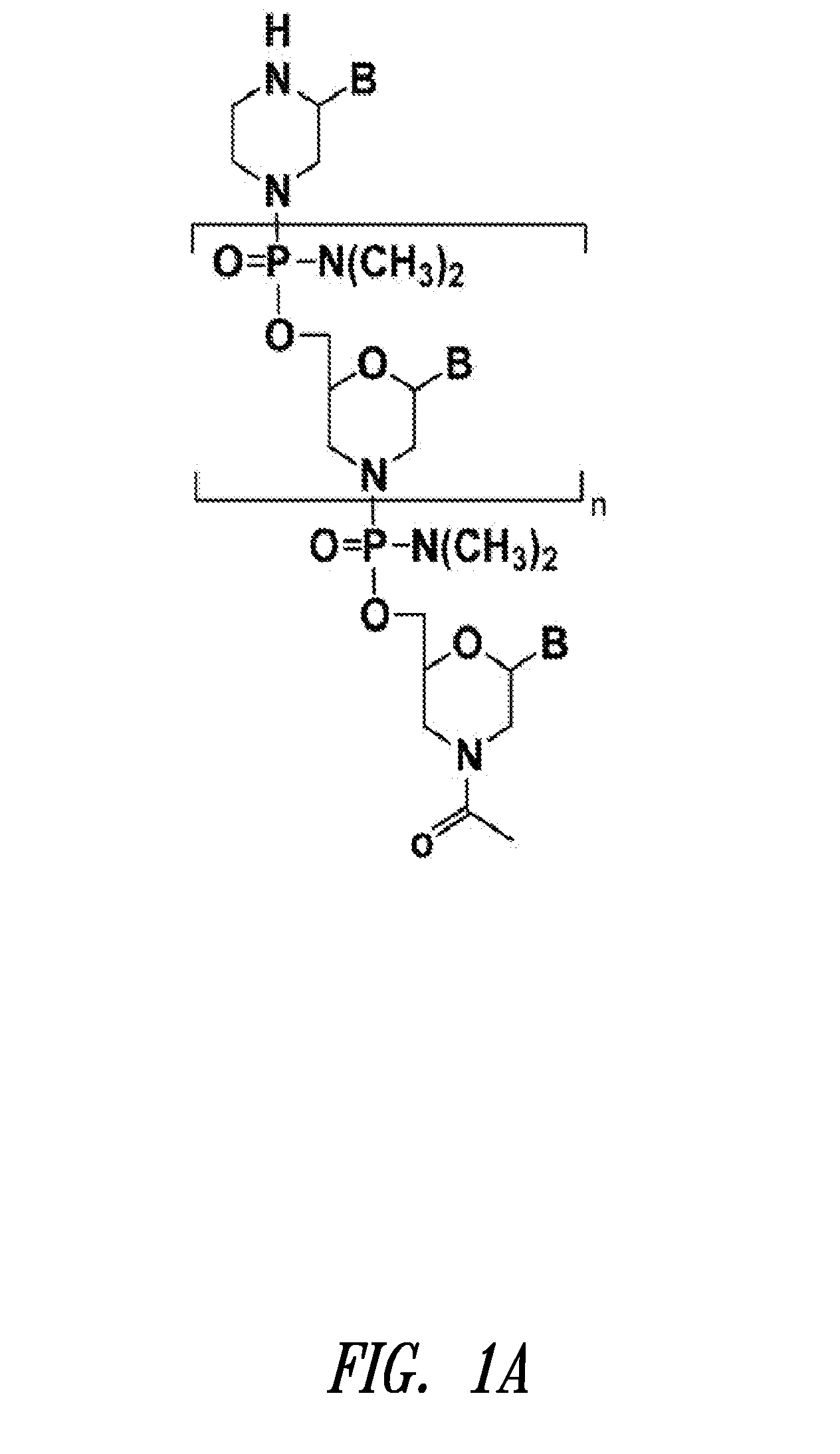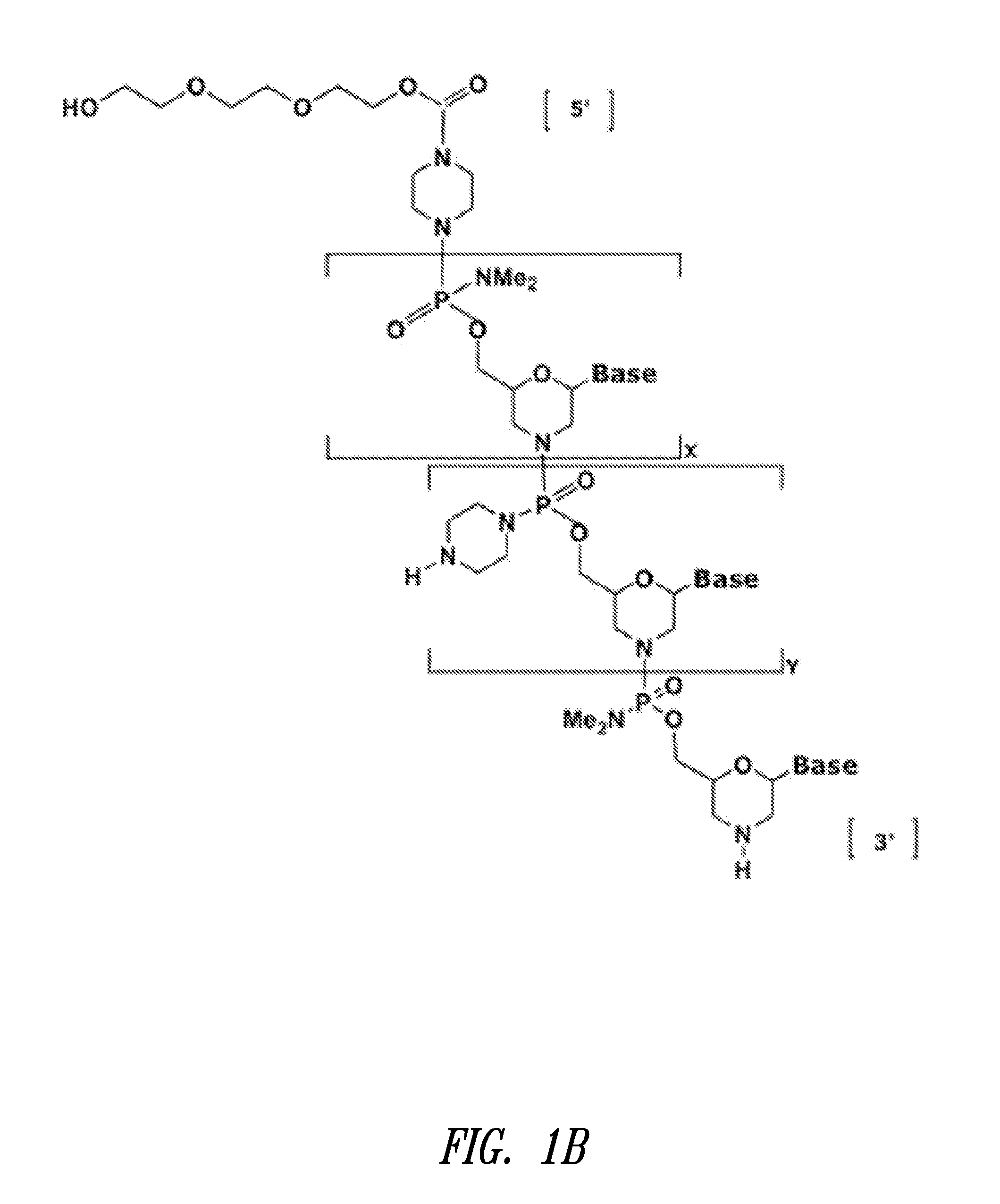Antisense modulation of nuclear hormone receptors
a technology antisense, which is applied in the field of antisense modulation of nuclear hormone receptors, can solve the problems of limited systemic use of nhrs, achieve the effects of reducing the transcription of one or more of their pro-inflammatory target genes, reducing and increasing the expression of a variant of nhr
- Summary
- Abstract
- Description
- Claims
- Application Information
AI Technical Summary
Benefits of technology
Problems solved by technology
Method used
Image
Examples
example 1
Activation of Glucocorticoid Receptor in an In Vivo Model System
[0386]Male Sprague Dawley rats were treated with vehicle (n=3) or glucocorticoid receptor antisense PMO targeting either GR exon 6 or exon 7 (SEQ ID NOs: 13 or 16, respectively) for three days at the dose of 30 mg / kg / day administered subcutaneously. The animals were subsequently challenged with dexamethasone and tyrosine aminotransferase (TAT) activity was measured in liver extracts six hours later. The target sequence for these two antisense oligomers between mouse and rats are conserved. The same two antisense oligomers were used to treat primary rat hepatocytes followed by measurement of TAT activity. The following table shows the level of TAT activity in the treated animals and primary hepatocytes relative to vehicle controls.
TABLE ATyrosine aminotransferase (TAT) activityNameSEQ ID NOTAT activity (% control)Observations in vitromuSA616+22.8muSA713+13.4Observations in vivomuSA616+81.2muSA713+50.2
[0387]The above resu...
example 2
Antisense Induced Alternative Splicing of Glucocorticoid Receptor Pre-mRNA in Rat Hepatocytes
[0388]To determine a molecular basis for the increased TAT activity described in Example 1, primary rat hepatocytes were treated with either dexamethasone at 100 nM, a MuSA6 peptide-conjugated PPMO at 5 μM (SEQ ID NO: 16 conjugated at the 3′ end to SEQ ID NO: 19) or a combination treatment with 100 nM dexamethasone and 5 μM MuSA6 PPMO. Total RNA was extracted and purified from Sprague Dawley primary rat hepatocytes using the QuickGene RNA cultured cell HC kit from Autogen. The resulting total RNA was reverse transcribed and PCR amplified using the SuperScript III 1-Step RTPCR kit from Life Technologies and the following primer pairs using standard conditions. The forward primer was directed to exon 4 (FWD: 5′ GTG CTG GAA GAA ACG ATT GC 3′) (SEQ ID NO:27) and the reverse primer was directed to exon 8 (REV: 5′ CAG TTG GTA AAA CCG TTG CC 3′) (SEQ ID NO:28). PCR amplification products using thes...
example 3
Pulmonary Administration of Antisense Agents Induces Alternative Splice Forms of the Glucocorticoid Receptor mRNA in an In Vivo Mouse Model
[0390]C57BL / 6 mice were treated intranasally with 100 μg of peptide-conjugated MuSA7 PPMO (SEQ ID NO: 13 conjugated at the 3′ end to SEQ ID NO: 19) in 40 μl of PBS at −48 hr, −24 hr and −4 h. LPS was then administered intranasally at 0 hr (50 ug / mouse in 50 μA PBS) to induce an inflammatory response in the lungs. The mice were sacrificed at 0 min, 40 min, 90 min, 6 hr, and 22 hr post-LPS treatment. Lung tissue was used for both extraction of mRNA and subsequent RT-PCR for glucocorticoid receptor mRNA splice variants. RNA was extracted as described in Example 2, but a murine-specific pair of PCR primers was used ((FWD: 5′-GTG CTG GAA GAA ATG ATT GC-3′) (SEQ ID NO:29) and (REV: 5′-GTT GAT AAA ACC GCT GCC-3′) (SEQ ID NO:30)), directed to the same locations in exons 5 and 8 as described for the primers in Example 2.
[0391]FIG. 5 shows the presence of ...
PUM
| Property | Measurement | Unit |
|---|---|---|
| Tm | aaaaa | aaaaa |
| Tm | aaaaa | aaaaa |
| Tm | aaaaa | aaaaa |
Abstract
Description
Claims
Application Information
 Login to View More
Login to View More - R&D
- Intellectual Property
- Life Sciences
- Materials
- Tech Scout
- Unparalleled Data Quality
- Higher Quality Content
- 60% Fewer Hallucinations
Browse by: Latest US Patents, China's latest patents, Technical Efficacy Thesaurus, Application Domain, Technology Topic, Popular Technical Reports.
© 2025 PatSnap. All rights reserved.Legal|Privacy policy|Modern Slavery Act Transparency Statement|Sitemap|About US| Contact US: help@patsnap.com



